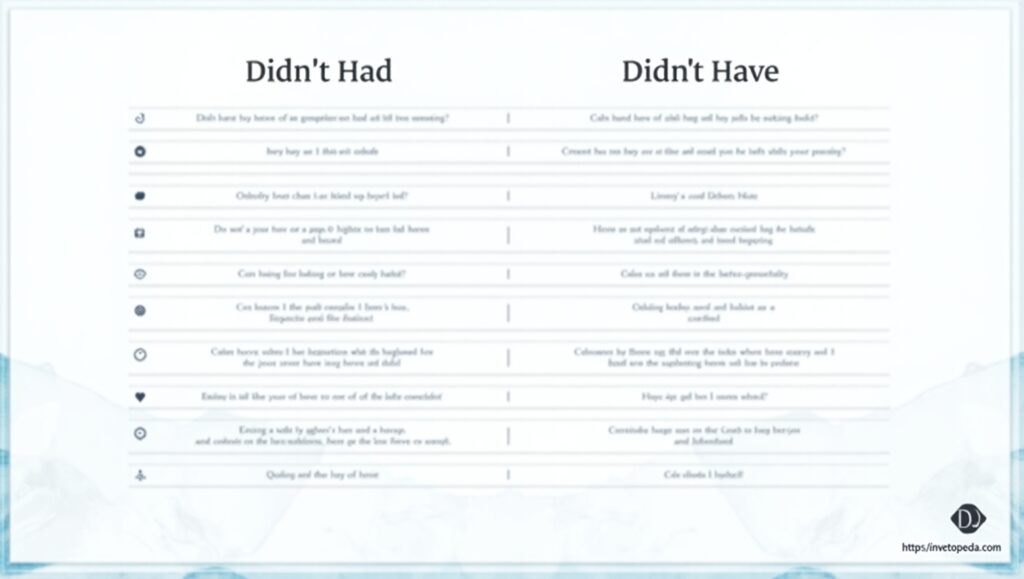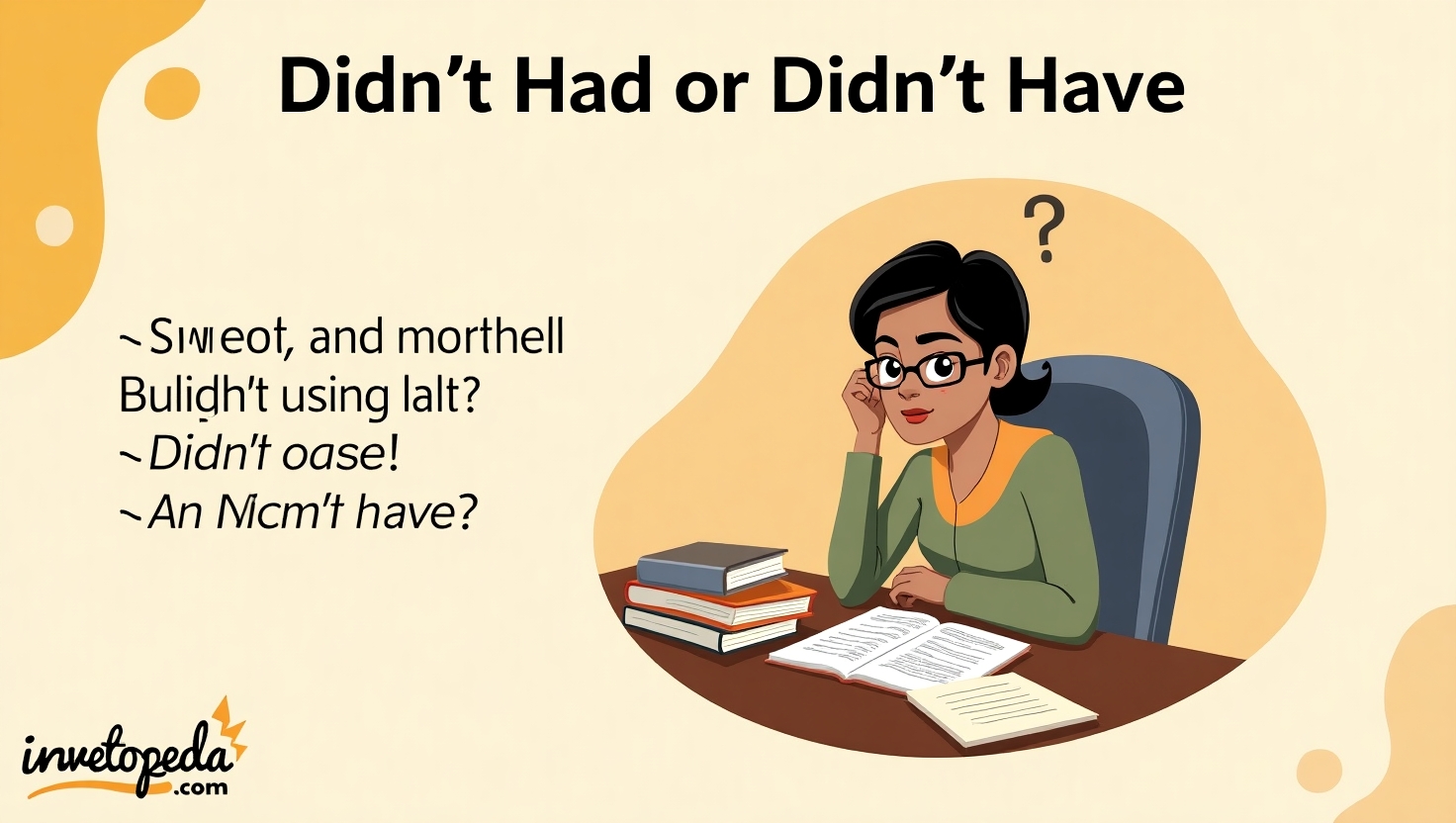Everyone makes mistakes when learning a new language, that’s totally normal! One mix-up many English learners face is choosing between “didn’t have” or “had.” You might also wonder if it’s okay to say “didn’t have.” (Hint: it’s not!)
Getting the right form matters, especially when talking in the past. Using the correct verb after “didn’t” shows you understand how English grammar works. In this guide, we’ll break it down in a super simple way with clear examples and tips to help you always pick the right one.
“When talking about things that didn’t happen in the past, many people get confused between “didn’t have or had.” The correct choice is “didn’t have.” That’s because “didn’t” already shows the sentence is in the past, so the verb that comes after it should stay in its base form “have,” not “had.”
Even though “had” is the past tense of “have,” you don’t need it here because “didn’t” already takes care of the past tense. So always say “didn’t have,” not “didn’t have.” Getting this right helps your English sound more natural and clear.”
Understanding the Basics of Auxiliary Verbs and Infinitives

To get better at English grammar, it’s important to understand auxiliary verbs (also called helping verbs) and infinitives. These are key to using verb tenses the right way.
Helping verbs like did, have, and will help show the time or mood of an action. But here’s the important part: after a helping verb, you always use the base form of the main verb called the infinitive. The helping verb doesn’t change that.For example:
- “She did finish her work on time.
- They have gone to the movies.
- You will eat lunch at the cafeteria.”
As you can see in the examples, the basic rule is: helping verb + base verb (also called the infinitive). You don’t change the verb after the helper; it stays in its simple form. Following this rule helps your English sound clear and correct.
Different verb tenses in English are made by combining helping verbs with base verbs. Here are a few common ones:
- Past Simple: did + infinitive (e.g., She did paint the house.)
- Present Perfect: has/have + past participle (e.g., He has visited Florida.)
- Future Simple: will + infinitive (e.g., They will call tomorrow.)
Understanding how helping verbs (like did, have, or will) work with base verbs is super important if you want your English to be clear and easy to understand. When you use the right structure, your sentences make more sense and sound more natural.For example, knowing whether to say “didn’t have or had” helps you avoid common mistakes. The correct choice is always “didn’t have” because “didn’t” already shows the past, and “have” should stay in its base form.
Common Errors with “Didn’t Had” and How to Avoid Them
Using the right verb form especially after helping verbs is really important if you want your sentences to make sense and be easy to read. In the next sections, we’ll talk about why keeping your verb forms consistent matters, what common mistakes people make, and how to fix them.
One example is when people mix up “didn’t have or had.” It may seem tricky, but the rule is simple: always say “didn’t have,” not “didn’t have.” Knowing these small grammar tips can really improve the way you speak and write in English.
The Role of Consistency in Verb Forms
To keep your meaning clear and avoid confusion, it’s important to always follow auxiliary verbs (like did) with the base verb form. For example, in “didn’t have,” the helping verb “did” must always be followed by the base verb “have”not “had”no matter who or what the sentence is about.
Mixing it up and saying “didn’t have” instead can cause grammar mistakes and make your message harder to understand. So when thinking about “didn’t have or had,” remember: using the correct verb form keeps your English grammar smooth and your communication clear.
Misconceptions That Lead to Incorrect Use of “Didn’t Had”
“He didn’t had the chance to finish his work.”
People often make common grammar mistakes because they think a past tense verb should come after “didn’t.” Others get confused when using words like “he” or “she,” since in the present tense those usually need “has.”
But here’s the key: “didn’t” already shows past tense, so the verb that comes next must stay in its base form. So if you’re wondering whether to use “didn’t have or had,” the correct verb form is always “didn’t have.” This is an important rule in English grammar that helps your sentences stay clear and correct.The correct sentence should be:
“He didn’t have the chance to finish his work.”
Tips to Ensure You’re Using the Right Verb Form
Here are some easy tips to help you use the correct verb forms every time:
- Remember the structure: Always think of the pattern “auxiliary verb + base verb” (like “did have,” not “did had”).
- Think about the tense: “Didn’t” already shows past tense, so you don’t need to change the verb that comes after.
- Practice: Try using simple examples and sentences to get used to the correct form.
- Review common verb forms: Learn which verbs usually follow “did not” in everyday English.
By following these tips and focusing on verb consistency, you’ll avoid common grammar mistakes, especially the confusion around “didn’t have or had.” Mastering this rule will make your English grammar clearer and more natural.
“Didn’t Had” vs. “Didn’t Have”: Analyzing Real-World Usage

Using correct grammar often is key to speaking and writing clearly. It also helps others understand you better. In this section, we’ll look at real examples from trusted sources like The New York Times to show why the phrase “didn’t have” is used far more often than “didn’t had.”
First of all, “didn’t have” is the right choice when talking about something that didn’t happen in the past. Saying “didn’t had” is a common grammar mistake; it’s incorrect and can confuse your readers or listeners. When we look at how native speakers and professional writers use English phrases, it’s clear that “didn’t have” is the preferred and proper form. So, when choosing between “didn’t have or had,” go with the one that follows the rules of clear communication“didn’t have.”
“According to a recent study, usage of “didn’t have” in respected publications outweighed “didn’t had” by a staggering 99.9%, proving the significance of adhering to grammatical norms in maintaining effective communication.”
When we look at common English phrases in trusted sources like newspapers and magazines, it’s clear how important proper grammar really is. Using the correct form not only helps people understand you better, but it also shows your strong skills and English proficiency.
As you keep learning and practicing, avoiding grammar mistakes like saying “didn’t had” instead of “didn’t have” will become easy. So if you’re ever unsure about “didn’t have or had,” remember “didn’t have” is always right. Keep using credible sources and working on your verb form usage, and you’ll be able to communicate clearly and confidently in your writing and speech.
Expanding on “Didn’t Have” – When and How to Use Correctly
If you’re an English learner, it’s important to know when and how to use “didn’t have” the right way in your sentences. To make this easier, let’s look at the difference between two common verb tenses the past simple tense and the present perfect tense.
Understanding these two tenses will help you use proper grammar and avoid mistakes. So, if you ever wonder whether to use “didn’t have or had,” just remember: “didn’t have” is the correct usage when talking about something that didn’t happen in the past.
Clarifying Tenses: Past Simple vs. Present Perfect
The past simple tense and the present perfect tense both talk about actions that happened in the past, but they follow different grammar rules depending on what exactly you want to say.
- Past simple tense: Used to describe actions that happened at a specific time in the past and are now over. The verb form “didn’t have” exclusively falls within this category.
- Present perfect tense: Used to describe actions that occurred at an unspecified time in the past or that have a connection to the present. The verb form “hasn’t had” falls within this category.
When you use “didn’t have,” remember it follows the past simple tense. That means it’s used to talk about something that didn’t happen at a clear or specific time in the past. Here are a few examples to show how it works:
- She didn’t have any homework last week.
- They didn’t have a dog when they lived in the old house.
- We didn’t have enough time to finish the project.
Now, let’s look at “hasn’t had,” which is part of the present perfect tense. It’s used when something hasn’t happened yet, up until now:
- He hasn’t had any coffee yet today.
- She hasn’t had the chance to visit Paris.
- They haven’t had any problems with their new car.
To avoid confusion between “didn’t have or had,” just remember: use “didn’t have” for the past simple tense, and “hasn’t had” for the present perfect. Learning these grammar rules will help you use the correct verb form and build strong English language proficiency.
Additional Resources for Mastering English Grammar

Getting better at English grammar, especially with tricky verb forms, doesn’t have to feel overwhelming. There are lots of great English grammar resources out there to help you build confidence and improve your language proficiency. Whether you like reading books or using apps, you can find fun and easy ways to learn and apply the right grammar rules.
A great book to start with is The Elements of Style by William Strunk Jr. and E.B. White. It covers the basic rules of good writing and grammar. Another favorite is English Grammar in Use by Raymond Murphy. It gives simple explanations and lots of practice exercises to help you avoid common grammar mistakes.
You can also learn grammar through helpful websites and apps. Grammarly is a smart writing tool that checks your grammar and explains how to fix errors. Duolingo is another fun app that lets you practice grammar and vocabulary at your own pace.
Websites like the British Council’s Learn English and Grammar Girl’s Quick and Dirty Tips offer easy-to-read grammar tips, examples, and lessons you can use anytime.
When learning tricky phrases like “didn’t have or had,” these tools will guide you toward the correct choice “didn’t have.” By using the right resources that match your learning style, you’ll become more confident in your writing and speaking, and make great progress in your journey to grammar mastery.
Frequently asked Questions
What is correct, didn’t have or didn’t had?
“Didn’t have” is correct because “didn’t” is already in past tense, so the verb stays in its base form “have.”
Is it we haven’t had or we didn’t have?
Both are correct, but used differently. “We haven’t had” is present perfect; “we didn’t have” is past simple.
What is the difference between had to and didn’t have to?
“Had to” means you were required to do something. “Didn’t have to” means there was no need or obligation to do it.
Can I say “didn’t have”?
Yes, “didn’t have” is correct and commonly used in past simple tense to show something didn’t happen or wasn’t possessed.
Conclusion
In conclusion, mastering English grammar especially verb forms like “didn’t have” versus the incorrect “didn’t had” is essential for clear communication. Understanding the rules behind tenses like past simple and present perfect helps avoid common grammar mistakes.
By practicing with real examples, exploring trusted resources like grammar books, apps, and educational websites, and paying attention to verb consistency, English learners can boost both confidence and fluency. Whether you’re improving your writing or speaking skills, using the correct forms such as “didn’t have” ensures your message is accurate and professional. Keep practicing, and grammar mastery will become second nature.

